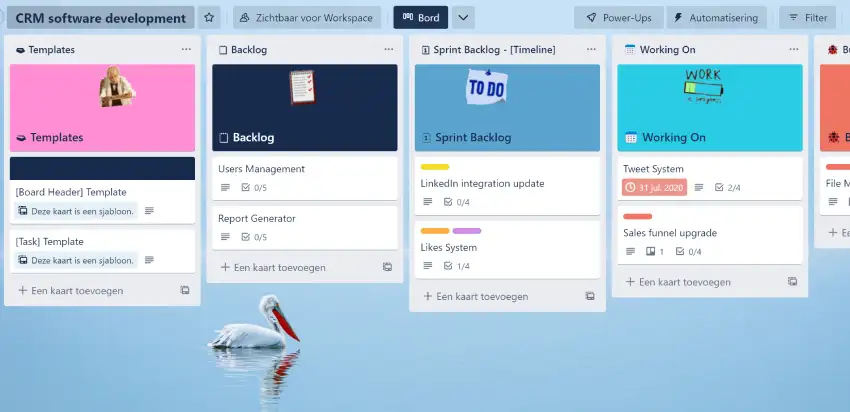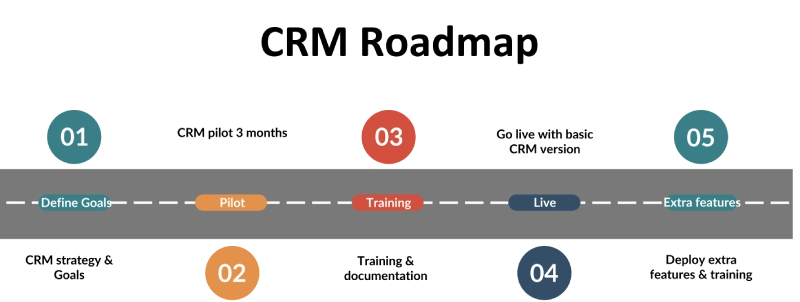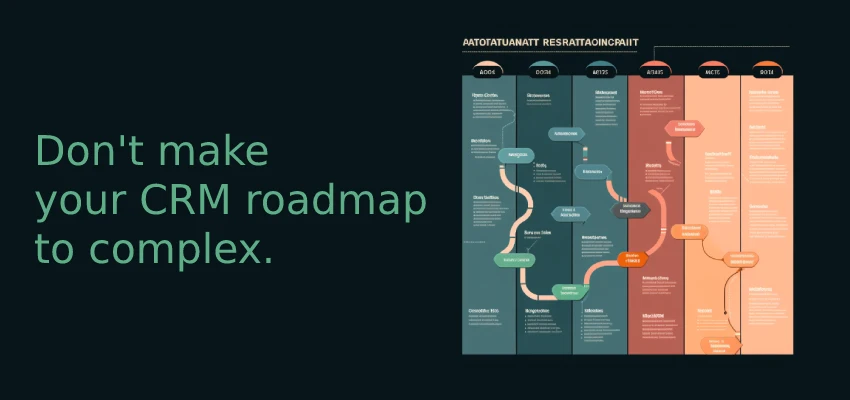Perfect! You get to work on CRM. 😎 A breath of fresh air is blowing through the organization and there is finally the prospect of fundamental support for the commercial team. Before you dive headlong into the CRM project now, it’s smart to think ahead. Have you considered your CRM roadmap yet?
What is a CRM roadmap? 🗺️
A CRM roadmap is a critical tool that outlines the future direction of an organization’s CRM strategy. It helps to align the CRM strategy with the overall business strategy, sets priorities, and identifies the steps required to achieve the CRM goals. The deployment of CRM usually has a central role in this window into the future. A CRM roadmap can be used to improve the organization’s customer service, enhance sales and marketing efforts, and streamline internal processes. Let’s discuss the benefits of a CRM roadmap and how it can help you and your organization to achieve your goals.
The most important benefits of a CRM roadmap
1. Everybody on the team knows what to expect
A CRM roadmap helps to create a shared understanding of the organization’s CRM strategy. By sharing the document with the entire team, everyone knows what to expect and can plan accordingly. This helps to ensure that everyone is working towards the same goals and reduces confusion.
It also helps to create a sense of ownership and accountability among team members. When everyone knows what their role is in achieving the CRM goals, they are more likely to take ownership of their work and be accountable for their results. This can lead to increased engagement and motivation, which can have a positive impact on the organization’s overall performance.

2. You channel new requests for functionality
With a CRM roadmap, you introduce a framework for evaluating new requests for functionality. When new requests are received, they can be evaluated against the roadmap to determine whether they align with the organization’s CRM strategy and goals. This helps to prevent ad-hoc requests that may not add value to the overall CRM strategy.
3. Easy to plan resources to develop new CRM functionalities and integrations
CRM is not isolated within your organization but is a part of the total IT landscape. New functionalities and integrations can bring a lot of value. A CRM roadmap provides a clear plan for the development of new functionalities and integrations.
By outlining the steps required to achieve the desired outcomes, organizations can plan their resources more effectively. This helps to ensure that the necessary resources, including budget, staff, and time, are available to take the necessary steps
4. You encourage the use of CRM within the organization
Securing CRM adoption is a major challenge for many companies. Training and a focus on reports can help. But also a CRM roadmap can encourage the use of CRM within the organization. By outlining the benefits of using the CRM system, organizations can motivate team members to use the system more effectively. The document can also give insights into training and support for team members, to learn how to use the CRM system more effectively.
The roadmap can also help to create a culture of accountability and transparency. By sharing the roadmap with the entire organization, team members can see how their work contributes to the overall CRM strategy.

These steps will help you create a CRM roadmap
However, creating a CRM roadmap requires careful planning and execution. Here are some steps that organizations can follow to create one:
1. Define the goals
The first step in creating a CRM roadmap is to define the goals that the organization wants to achieve through its CRM system. These goals should align with the overall business strategy and should be specific, measurable, achievable, relevant, and time-bound (SMART).
2. Identify the stakeholders
The next step is to identify the stakeholders who will be involved in the strategy and CRM planning. This may include senior management, IT staff, sales and marketing staff, customer service staff, and other relevant personnel.
3. Assess the current CRM-situation
Organizations should assess the current state of their CRM system to identify any gaps or areas for improvement. This may involve conducting a needs assessment, analyzing data, and gathering feedback from stakeholders.
4. Develop a roadmap
Based on the goals, stakeholders, and assessment, organizations can develop a roadmap that outlines the steps required to achieve the desired outcomes. The roadmap should include timelines, milestones, and key performance indicators (KPIs) to track progress.
5. Communicate the CRM roadmap
The final step is to communicate the roadmap to all stakeholders. This may involve conducting training sessions, sharing documentation, and providing regular updates on progress.
You can always choose to make the roadmap visually attractive and, for example, hang it up as posters in the company. This will bring the project to life within the organization. Think carefully about the design; a complex visual representation actually detracts from your goal.

To conclude
In conclusion, a CRM roadmap is a critical tool that can help organizations to achieve their CRM goals. It provides a framework for aligning the CRM strategy with the overall business strategy, sets priorities, and identifies the steps required to achieve the desired outcomes.
By channeling new requests, organizations can make strategic decisions about the direction of their CRM system, prioritize resources, and invest in areas that will have the greatest impact on their overall CRM strategy.
Additionally, it can help to encourage the use of CRM within the organization, leading to increased engagement and motivation. By following the steps outlined above, organizations can create an effective CRM roadmap that will help them to build long-term relationships with their customers, increase sales, and improve customer satisfaction.
💡Need help with your CRM? Compare systems with our CRM comparison tool or reed our CRM reviews.
Check our hand picked top 3 CRMs with Marketing Automation 👇
This website uses cookies. By continuing to use this site, you accept our use of cookies. Learn more
